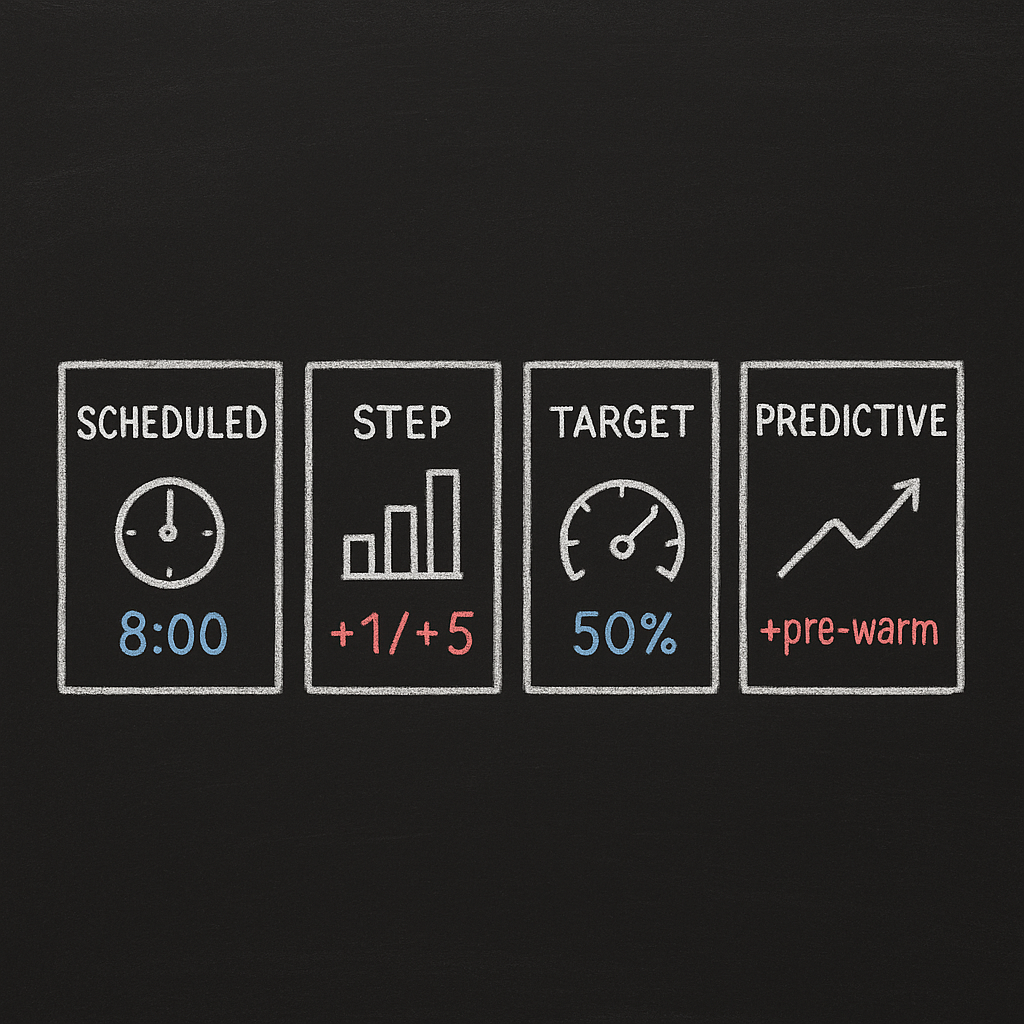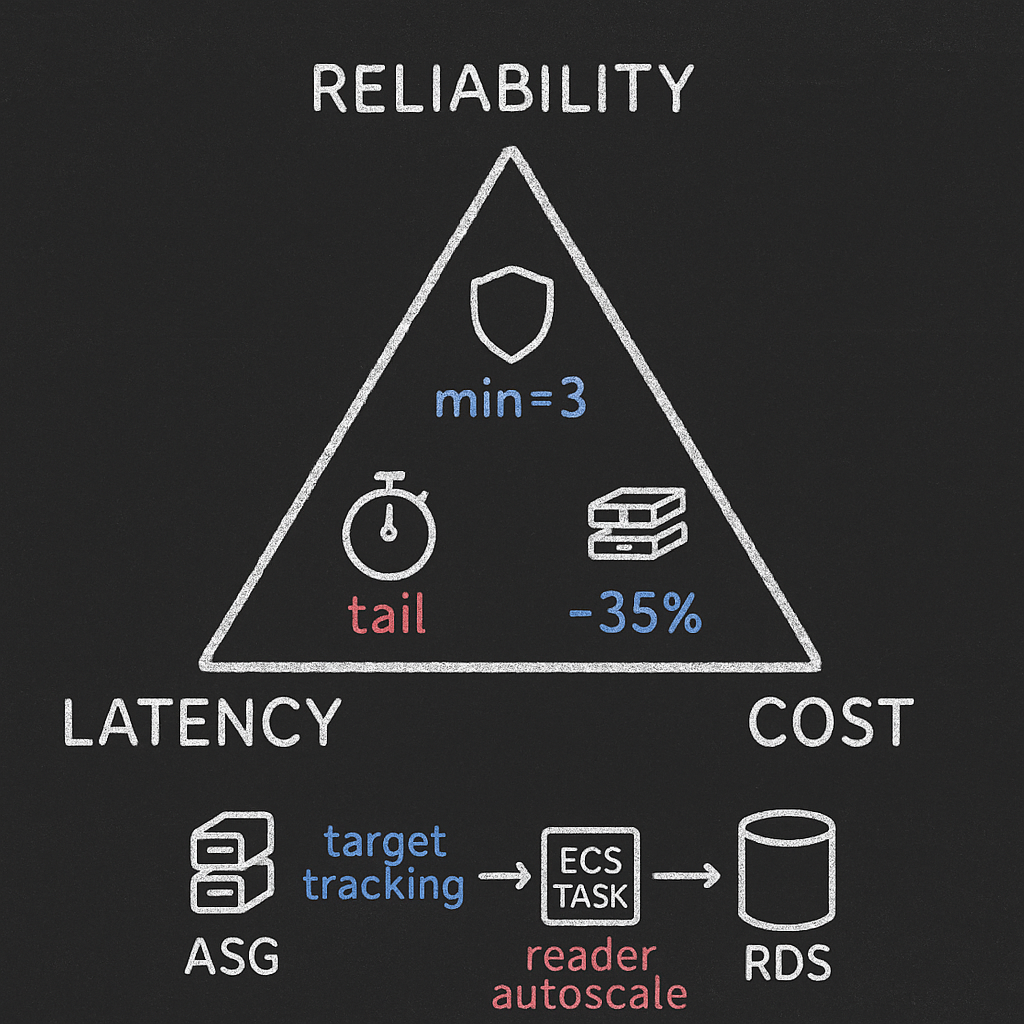AWS EC2, ECS, and RDS auto scaling best practices for real‑world teams
Are you spending for peak and still seeing latency during spikes? The right auto scaling strategy can cut waste while improving reliability—if you implement it precisely.
This guide deconstructs scheduled, step, target, and predictive scaling across EC2, ECS, and RDS. You’ll get configuration examples, testing and monitoring steps, and pragmatic trade‑offs to keep performance high while lowering cost.

What you’ll learn
- When to use scheduled vs. step vs. target vs. predictive scaling
- How to configure scaling for EC2 Auto Scaling Groups (ASG), ECS services, and RDS/Aurora
- Trade‑offs between reliability, latency, and cost
- Monitoring and load-testing workflows to validate policies before production
- Cost reductions that don’t compromise SLOs
For a quick primer, see our overview on aws automatic scaling.
Core components you must get right
EC2 Auto Scaling has three building blocks: launch templates, Auto Scaling Groups, and scaling policies. AWS explains these in the EC2 Auto Scaling user guide.
ECS Service Auto Scaling uses Application Auto Scaling to adjust task counts based on CPU, memory, or custom metrics.
RDS/Aurora: Aurora supports reader Auto Scaling via Application Auto Scaling; standard RDS supports storage autoscaling and vertical scaling (instance size), which you can orchestrate via maintenance windows, runbooks, or event-driven automation.
AWS also provides a centralized “AWS Auto Scaling” console that unifies scaling plans across services; see the AWS Auto Scaling FAQs for capabilities and limits.
Scaling policy types explained (and when to use each)
Scheduled scaling
What it does: Executes scale actions at specific times (e.g., weekdays at 8:00 a.m.).
Best for: Predictable, time-based patterns (open/close hours, batch windows).
Watch out for: Holidays and seasonality—keep calendars updated.
Step scaling
What it does: Uses multiple thresholds for a metric with different adjustments per breach magnitude.
Best for: Non-linear workloads where a small spike needs +1 instance, but a big spike needs +5.
Watch out for: Overlapping with target tracking—use one “primary” policy per metric.
Target tracking scaling
What it does: Maintains a target metric (e.g., 50% CPU) by continuously adjusting capacity.
Best for: Most web/API/worker services.
Watch out for: Set realistic targets and cooldowns to avoid flapping.
Predictive scaling
What it does: Forecasts traffic and raises the minimum capacity ahead of time; target tracking handles real-time variance. See AWS Auto Scaling FAQs.
Best for: Stable daily/weekly patterns (e.g., business hours), where cold start latency hurts.
Watch out for: Forecast drift—validate against recent history and keep a small buffer.
EC2 Auto Scaling (ASG) patterns and examples
Use an ASG with a launch template and one primary policy (target tracking) plus optional scheduled or predictive policies.
Minimal CloudFormation skeleton:
Resources: AppAsg: Type: AWS::AutoScaling::AutoScalingGroup Properties: MinSize: 2 MaxSize: 10 DesiredCapacity: 3 VPCZoneIdentifier: [subnet-abc, subnet-def] LaunchTemplate: LaunchTemplateId: lt-0123456789abcdef0 Version: 1 HealthCheckType: EC2 HealthCheckGracePeriod: 300Target tracking policy (CPU 50%):
{ "AutoScalingGroupName": "app-asg", "PolicyType": "TargetTrackingScaling", "TargetTrackingConfiguration": { "PredefinedMetricSpecification": { "PredefinedMetricType": "ASGAverageCPUUtilization" }, "TargetValue": 50.0, "DisableScaleIn": false }}Scheduled scale for weekday morning ramp:
aws autoscaling put-scheduled-update-group-action \ --auto-scaling-group-name app-asg \ --scheduled-action-name weekday-warmup \ --recurrence "0 8 * * 1-5" \ --min-size 4 --max-size 12 --desired-capacity 6Best practices for EC2 ASGs
Choose target tracking as your default. Add step scaling only for known non-linearities (e.g., queue-depth surges).
Cooldowns and grace periods: Start with 300–600 seconds, align with app initialization and connection draining. AWS details health checks and lifecycle hooks in the EC2 Auto Scaling guide.
Warm pools: Pre-initialize instances to reduce scale-out latency if your AMI/user data takes minutes to boot. This improves tail latency but adds cost—tune pool size.
Scale-in safety: Use instance scale-in protection for stateful nodes; drain connections via lifecycle hooks before termination.
Cost levers for EC2
Right-size first: Oversized instances are 30–50% of compute waste. Our data shows 40% of EC2 runs under 10% CPU at peak, and right-sizing can reduce EC2 costs by ~35% without performance impact. See aws cost management best practices.
Graviton migration: GOV.UK realized ~15% per-instance savings moving from m6i to m7g, with more when combined with right-sizing.
Savings Plans plus Spot for burst: Baseline with Savings Plans, burst with Spot (with On‑Demand fallback) for 60–90% savings on fault-tolerant portions.
Off-hours automation for dev/test: Up to 70% lower cost by shutting down during nights/weekends.
For deeper EC2/EBS tuning, see optimized ebs volume sizing and performance tuning aws.
ECS Service Auto Scaling patterns and examples
Two layers to consider:
- Service Auto Scaling: Adjusts task count.
- Capacity Providers (for EC2 launch type): Manages cluster instance capacity to match tasks.
Target tracking on CPU (ECS service):
{ "ScalableTargetAction": { "ServiceNamespace": "ecs", "ResourceId": "service/cluster-name/service-name", "ScalableDimension": "ecs:service:DesiredCount", "MinCapacity": 2, "MaxCapacity": 50 }, "ScalingPolicy": { "PolicyName": "cpu-50", "PolicyType": "TargetTrackingScaling", "TargetTrackingScalingPolicyConfiguration": { "TargetValue": 50.0, "PredefinedMetricSpecification": { "PredefinedMetricType": "ECSServiceAverageCPUUtilization" }, "ScaleInCooldown": 300, "ScaleOutCooldown": 120 } }}Capacity Providers with Managed Scaling (EC2 mode):
- Attach an ASG to a capacity provider with target capacity (e.g., keep cluster at 85% utilization).
- This lets ECS add/remove EC2 instances automatically as tasks scale.
Best practices for ECS
Prefer target tracking on CPU/memory; add custom metrics (requests per task, queue depth) via CloudWatch if needed.
For spiky web traffic, use Fargate to avoid EC2 capacity lag—or enable EC2 warm pools plus Capacity Providers.
Use circuit breakers and graceful shutdown to avoid killing tasks mid-request during scale-in.
Cost levers for ECS
Choose Fargate for bursty or small fleets; EC2 for steady baselines you can right-size and discount.
Mix On‑Demand baseline with Spot capacity provider for batch/queue workers.
Keep task definitions memory-aligned; over-requested memory leads to underutilization.
RDS and Aurora scaling patterns (and realistic limitations)
Aurora
Reader Auto Scaling: Application Auto Scaling can add/remove Aurora Replicas based on metrics like CPU or ReplicationLag.
Serverless v2: Scales capacity units continuously without connection drops, ideal for variable workloads with strict latency.
Use target tracking on CPU/lag for readers; scheduled minimums for business hours.
Standard RDS (MySQL/PostgreSQL/etc.)
Storage autoscaling: Increases allocated storage automatically as you approach thresholds.
Vertical instance scaling: Requires a restart; schedule during low-traffic windows. You can automate via maintenance windows or event-driven pipelines, but it’s not “instant autoscaling.”
Read replicas: No native “auto” replica count for non‑Aurora. You can approximate with CloudWatch + Lambda runbooks, but consider Aurora if you need true elasticity.
Trade‑offs
Reader autoscaling improves read throughput but doesn’t fix write saturation—watch primary instance CPU/IOPS.
Vertical scaling events are disruptive; plan scheduled windows and connection draining.
For true elasticity, Aurora Serverless v2 minimizes human-in-the-loop scaling decisions.
AWS documents these service behaviors in the EC2 Auto Scaling guide and AWS Auto Scaling FAQs.
Choosing the right policy for your workload
Web/API (stateless): Target tracking on CPU 40–60% or request-per-target metric. Add predictive scaling or scheduled warmup for morning spikes.
Queue/worker: Target tracking on queue depth per instance (custom metric), step scaling for surge thresholds, and Spot capacity where safe.
Batch/analytics: Scheduled blocks and big step increments; use Spot generously with checkpointing.
Databases: Aurora reader target tracking; scheduled min capacities for trading/market hours; for standard RDS use storage autoscaling and planned vertical scaling.
Reliability, latency, and cost trade‑offs
Reliability
Higher minimum capacity and warm pools increase resilience to sudden spikes, but cost more.

Multi‑AZ and distribution across AZs increase fault tolerance; ensure health checks are load‑balancer aware.
Latency
Cold starts (new EC2 instances, cold JVMs) degrade tail latency. Predictive scaling and warm pools reduce this.
For ECS on EC2, capacity provider lag can add minutes; Fargate launches are typically faster for scaling bursts.
Cost
Oversized targets (e.g., 30% CPU) raise cost; too aggressive scale-in can cause thrash and hidden latency costs.
Predictive scaling reduces overprovisioning for stable cycles but can overshoot when patterns shift—validate frequently.
Monitoring the right signals
Essential CloudWatch signals (EC2 ASG)
- GroupDesiredCapacity, GroupInServiceInstances, GroupPendingInstances
- AutoScalingScaleOutSuccess, AutoScalingScaleInSuccess
- Target metric: ASGAverageCPUUtilization, ALB RequestCountPerTarget, or custom SQS depth per instance
ECS
- Service CPU/MemoryUtilization, Desired/Running task count
- Capacity provider metrics: cluster utilization, instance pending/running
RDS/Aurora
- CPUUtilization, DatabaseConnections, FreeableMemory, ReadIOPS/WriteIOPS
- Aurora: ReplicationLag, Serverless capacity units
AWS outlines ASG monitoring in the EC2 Auto Scaling documentation. FAQs detail policy behaviors in the AWS Auto Scaling FAQs.
Safe testing and validation workflow
Stage it
Clone production configs to a staging ASG/ECS service with reduced limits.
Lower thresholds temporarily to force scale events and verify hooks, drain, and cooldown behavior.
Load test
Use traffic tools like hey or wrk to simulate spikes. Observe desired vs. in‑service capacity, and request latency.
Failure drills
Kill instances/tasks to test health checks, replacement behavior, and connection draining.
Validate alarms, runbooks, and rollback paths.
Bake time
Let new policies run through a few traffic cycles before promoting to production defaults.
Track cost deltas alongside performance.
A short demo of this approach is shown in community resources like this scaling test walkthrough.
Cost optimization checklist without sacrificing performance
Right-size first, then scale: It’s common for 40% of instances to sit below 10% CPU at peak. Fixing this yields ~35% EC2 savings. See aws cost management best practices.
Use Graviton and Savings Plans: Combining Graviton with Savings Plans can deliver 40–70% lower compute cost vs. on‑demand x86. For broader commercial discounts, consider the aws discount program.
Mix Spot safely: Run fault‑tolerant tiers on Spot with On‑Demand fallback for 60–90% savings; design for interruptions with graceful drains and retries.
Predictive or scheduled warmups: Pre-scale before known peaks to protect tail latency; keep buffers small and review weekly.
Turn off non-prod: Automate nightly/weekend shutdowns for dev/test to save up to 70%.
Tune EBS to remove IO bottlenecks: Bottlenecked disks cause false scale-outs; fix storage first. See amazon ebs best practices.
Watch quotas and limits: Ensure service quotas (ASGs, policies, instance caps) won’t block a scale-out. AWS documents quotas in the Auto Scaling guide.
Track business KPIs: Pair CloudWatch with unit economics (cost/request, cost/txn) so scaling choices are financially intelligent. For a broader view, see aws vs azure performance comparison and, if you’re evaluating providers, gcp vs aws cost.
Frequently asked (quick answers)
What’s the difference between scheduled and step scaling?
- Scheduled is time‑based; step is metric‑based with tiered thresholds.
Predictive vs. scheduled?
- Both anticipate demand. Predictive uses forecasts and works with target tracking; scheduled is fixed time rules. See the AWS Auto Scaling FAQs.
What are the EC2 Auto Scaling components?
- Launch template, Auto Scaling Group, scaling policies. Covered in EC2 Auto Scaling docs.
EC2 Auto Scaling vs. AWS Auto Scaling?
- EC2 Auto Scaling is specific to EC2. “AWS Auto Scaling” coordinates scaling plans across multiple services (EC2, ECS, DynamoDB, Aurora), per the FAQs.
Disadvantages of Auto Scaling?
- Cold starts, mis-tuned policies (thrash), quota blocks, and forecast drift. Mitigate with warm pools, cooldowns, and regular validation.
Put your savings on autopilot
Done right, auto scaling cuts idle spend while protecting latency during spikes. Most teams leave 20–40% on the table through oversized baselines, missing schedules, or mis-tuned thresholds. Hykell finds and fixes these gaps automatically—rate optimization, right‑sizing, EBS/EC2 tuning, Kubernetes and ECS efficiency—so you save up to 40% without touching performance. We only take a share of what you save.
Get started at Hykell or dive deeper into aws automatic scaling.
